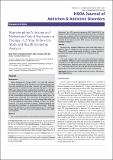Files in this item
Buprenorphine/naloxone and methadone opioid replacement therapy : a 2-year follow-up study and health economic analysis
Item metadata
| dc.contributor.author | Kidd, Brian | |
| dc.contributor.author | Renwick, Charlotte | |
| dc.contributor.author | Parrott, Steve | |
| dc.contributor.author | Matthews, Keith | |
| dc.contributor.author | Baldacchino, Alexander Mario | |
| dc.date.accessioned | 2019-06-17T10:30:05Z | |
| dc.date.available | 2019-06-17T10:30:05Z | |
| dc.date.issued | 2019-04-03 | |
| dc.identifier | 259331412 | |
| dc.identifier | c05f4773-0e39-4df0-a634-ebfa25287042 | |
| dc.identifier.citation | Kidd , B , Renwick , C , Parrott , S , Matthews , K & Baldacchino , A M 2019 , ' Buprenorphine/naloxone and methadone opioid replacement therapy : a 2-year follow-up study and health economic analysis ' , Journal of Addiction & Addictive Disorders , vol. 6 , no. 1 , 24 . https://doi.org/10.24966/AAD-7276/100024 | en |
| dc.identifier.issn | 2578-7276 | |
| dc.identifier.other | ORCID: /0000-0002-5388-7376/work/60196819 | |
| dc.identifier.uri | https://hdl.handle.net/10023/17906 | |
| dc.description.abstract | Background Opioid Replacement Therapy (ORT) is the main UK treatment for opiate dependency. Both methadone and buprenorphine-based drugs are licensed for this purpose in the UK with over 25,000 people prescribed in Scotland, mostly receiving methadone. Choice of ORT agent reflects historic guidance that methadone was the ‘first line’ recommendation if both were suitable. Now, evidence suggests that both are equally effective, although concerns regarding a higher risk of methadone overdose have been raised. Many factors, including higher costs and time commitment to dispense buprenorphine-based products, however, may have affected their wider use in the UK. Clinicians require better evidence to inform their clinical decisions. This study considers a cohort of treatment-seeking opiate-dependent individuals in a single health board area in Scotland, prescribed methadone or buprenorphine/naloxone ORT, comparing 2-year retention rates with the costs of treatment delivery and health care utilization. Methods We compared 62 patients receiving buprenorphine/naloxone (as Suboxone©) with 175 receiving methadone ORT (Total N=237). The health economic component reports only those for whom a complete dataset was available (n=212). Administrative NHS data was used to assess treatment retention and costs over a two year period. Costs included those associated with ORT delivery as well as broader healthcare utilization. Results No statistically significant differences were found with respect to retention rates or healthcare costs though the Cost Effectiveness Plane (CEP) showed considerable uncertainty in these results implying that retention may be greater in the methadone group. Conclusion This study suggests that, when combining all treatment delivery and additional healthcare costs, buprenorphine/naloxone is broadly equivalent in cost effectiveness to methadone ORT when delivered in the NHS system. Retention rates over 2 years were also comparable. These data may support the view that buprenorphine/naloxone represents a cost-neutral alternative ORT to that of methadone. | |
| dc.format.extent | 9 | |
| dc.format.extent | 725859 | |
| dc.language.iso | eng | |
| dc.relation.ispartof | Journal of Addiction & Addictive Disorders | en |
| dc.subject | Buprenorphine | en |
| dc.subject | Health economic analysis | en |
| dc.subject | Methadone | en |
| dc.subject | Opioid dependency | en |
| dc.subject | RA Public aspects of medicine | en |
| dc.subject | RM Therapeutics. Pharmacology | en |
| dc.subject | NDAS | en |
| dc.subject.lcc | RA | en |
| dc.subject.lcc | RM | en |
| dc.title | Buprenorphine/naloxone and methadone opioid replacement therapy : a 2-year follow-up study and health economic analysis | en |
| dc.type | Journal article | en |
| dc.contributor.institution | University of St Andrews. School of Medicine | en |
| dc.contributor.institution | University of St Andrews. Population and Behavioural Science Division | en |
| dc.contributor.institution | University of St Andrews. Centre for Minorities Research (CMR) | en |
| dc.identifier.doi | 10.24966/AAD-7276/100024 | |
| dc.description.status | Peer reviewed | en |
This item appears in the following Collection(s)
Items in the St Andrews Research Repository are protected by copyright, with all rights reserved, unless otherwise indicated.

